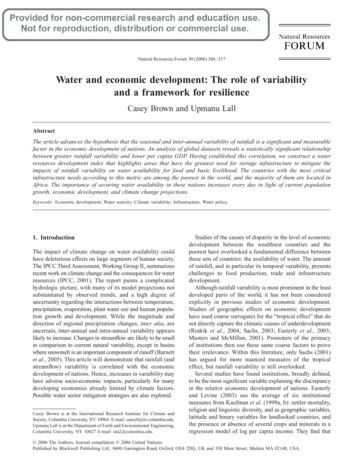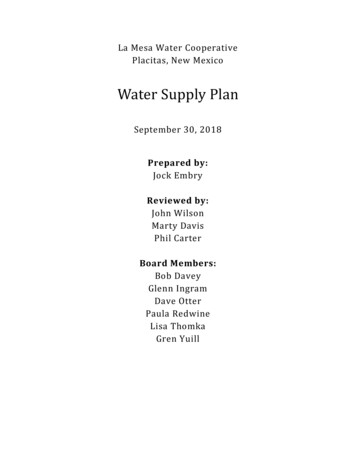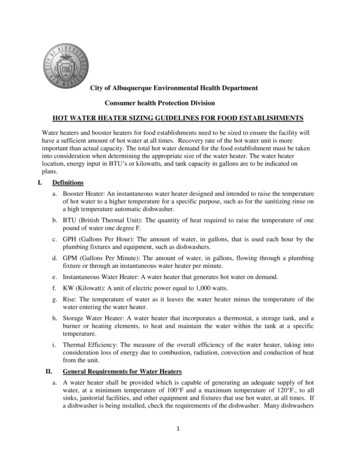
Transcription
Natural Resources Forum 30 (2006) 306–317Blackwell Publishing LtdWater and economic development: The role of variabilityand a framework for resilienceCasey Brown and Upmanu LallAbstractThe article advances the hypothesis that the seasonal and inter-annual variability of rainfall is a significant and measurablefactor in the economic development of nations. An analysis of global datasets reveals a statistically significant relationshipbetween greater rainfall variability and lower per capita GDP. Having established this correlation, we construct a waterresources development index that highlights areas that have the greatest need for storage infrastructure to mitigate theimpacts of rainfall variability on water availability for food and basic livelihood. The countries with the most criticalinfrastructure needs according to this metric are among the poorest in the world, and the majority of them are located inAfrica. The importance of securing water availability in these nations increases every day in light of current populationgrowth, economic development, and climate change projections.Keywords: Economic development; Water scarcity; Climate variability; Infrastructure; Water policy.1. IntroductionThe impact of climate change on water availability couldhave deleterious effects on large segments of human society.The IPCC Third Assessment, Working Group II, summarizesrecent work on climate change and the consequences for waterresources (IPCC, 2001). The report paints a complicatedhydrologic picture, with many of its model projections notsubstantiated by observed trends, and a high degree ofuncertainty regarding the interactions between temperature,precipitation, evaporation, plant water use and human population growth and development. While the magnitude anddirection of regional precipitation changes, inter alia, areuncertain, inter-annual and intra-annual variability appearslikely to increase. Changes in streamflow are likely to be smallin comparison to current natural variability, except in basinswhere snowmelt is an important component of runoff (Barnettet al., 2005). This article will demonstrate that rainfall (andstreamflow) variability is correlated with the economicdevelopment of nations. Hence, increases in variability mayhave adverse socio-economic impacts, particularly for manydeveloping economies already limited by climate factors.Possible water sector mitigation strategies are also explored.Casey Brown is at the International Research Institute for Climate andSociety, Columbia University, NY 10964. E-mail: caseyb@iri.columbia.edu.Upmanu Lall is at the Department of Earth and Environmental Engineering,Columbia University, NY 10027 E-mail: ula2@columbia.edu.Studies of the causes of disparity in the level of economicdevelopment between the wealthiest countries and thepoorest have overlooked a fundamental difference betweenthese sets of countries: the availability of water. The amountof rainfall, and in particular its temporal variability, presentschallenges to food production, trade and infrastructuredevelopment.Although rainfall variability is most prominent in the leastdeveloped parts of the world, it has not been consideredexplicitly in previous studies of economic development.Studies of geographic effects on economic developmenthave used coarse surrogates for the “tropical effect” that donot directly capture the climatic causes of underdevelopment(Rodrik et al., 2004; Sachs, 2003; Easterly et al., 2003;Masters and McMillan, 2001). Promoters of the primacyof institutions then use these same coarse factors to provetheir irrelevance. Within this literature, only Sachs (2001)has argued for more nuanced measures of the tropicaleffect, but rainfall variability is still overlooked.Several studies have found institutions, broadly defined,to be the most significant variable explaining the discrepancyin the relative economic development of nations. Easterlyand Levine (2003) use the average of six institutionalmeasures from Kaufman et al. (1999a, b): settler mortality,religion and linguistic diversity, and as geographic variables,latitude and binary variables for landlocked countries, andthe presence or absence of several crops and minerals in aregression model of log per capita income. They find that 2006 The Authors. Journal compilation 2006 United Nations.Published by Blackwell Publishing Ltd., 9600 Garsington Road, Oxford, OX4 2DQ, UK and 350 Main Street, Malden MA 02148, USA.
Casey Brown and Upmanu Lall / Natural Resources Forum 30 (2006) 306–317institutions dominate the other variables. Acemeglou et al.(2001) use settler mortality rates as an exogenous measureof institutions and arrive at similar results. Climate entersin the form of temperature highs and lows, and humidityhighs and lows, which are statistically insignificant. Finally,Rodrik et al. (2004), in a very comprehensive study thatfollows the methodology of previous efforts and incorporatesseveral tests of robustness, finds again that the quality ofinstitutions is the most important explanatory variable andthat geography as measured by their preferred instrument,distance from the equator, does have an effect, albeit weaker.Perhaps surprisingly, this literature finds that colonial domination and military conquest are not significant factors relativeto the causes cited above (see Sachs, 2001).Many other studies argue in favour of the significant impactof geography (Sachs, 2001; Masters and McMillan, 2001;Olsson and Hibbs, 2000; Mellinger et al., 1999; Gallup et al.,1998; Diamond, 1997). Sachs (2001) describes the tropicaldisadvantage in agriculture as being due to poor soils, thepresence of pests and parasites, higher crop respirationrates due to warmer temperatures and difficulty with wateravailability and control. However, studies investigating theimpact of geography on development have not included anymeasure of water availability in general or water variabilityin particular. Sachs (2001, 2003) argues that measures ofgeography must be more nuanced than simply distancefrom the equator, a favourite choice of some authors (Rodriket al., 2004). Accordingly, the use of percentage populationliving within the Köppen-Geiger ecozones (see Geiger andPohl, 1954) categorized as tropical or temperate is probablythe best representation of climate as an independent explanatoryvariable within this literature. No previous cross-countryanalysis includes the temporal variability of rainfall, afundamental factor in the tropical effect.Recent country-level studies suggest that the impacts ofhydrology and rainfall variability on economic developmentare significant (World Bank, 2004; Grey and Sadoff, 2006).In Ethiopia, a study using an economy-wide model, that includedhydrologic variability effects, found that the occurrence ofdroughts and floods reduced economic growth by morethan one third (Grey and Sadoff, 2006). Losses in Kenyadue to flooding associated with El Niño in 1997–1998 andthe La Niña drought in 1998–2000 caused annual damageranging from 10–16% of GDP during this period. Interestingly,the most damage was not incurred by agriculture. Transportlosses represented 88% of flood losses and foregonehydropower and industrial production totalled 84% of thedrought losses (World Bank, 2004).Many parts of the world experience a high degree of intraannual rainfall variability. This is typical of the tropics, markedby the cycle of wet and dry seasons: too much water in oneseason followed by too little in another. The impacts oneconomic activity are widespread. A season of concentratedheavy rainfall can inundate the means of transportation,which in turn limits trade potential and communication,and can flood homes and offices. The rainfall in a typical 2006 The Authors. Journal compilation 2006 United Nations.307wet season exceeds the infiltration and storage capacity ofsoils and a large portion is lost as runoff. Flooding rivers,inundated roads and landslides in mountainous regions hindermovement, transport and trade. In the dry season, agricultureis constrained by lack of water and high temperatures. Anextended dry season may bar crop production and reducethe flow of surface waters that could otherwise provideirrigation, navigation and hydroelectricity production. Riversflow only seasonally. Aquifers can be tapped throughout theyear, but the required well boring technology is a recentdevelopment.Living in these areas, one can expect to receive all theyear’s rainfall in a spell of about four months. Agricultureis tuned to this rhythm, planting crops to coincide with thearrival of the rainy season. Farmers in monsoon climatesthat are marked by a distinct transition from dry to wetseasons face difficult decisions regarding when to planttheir crops. Plant too early and the seeds may not germinatewithout adequate rain; plant too late and the wet seasonmay end prior to the end of the crops’ growth. Farmers inareas with less variability in the annual cycle of rainfall donot face this dilemma. This sensitivity to the timing of thearrival and departure of the rainy season requires differentmethods than those used in regions where rainfall is moreequally distributed throughout the year, and where the keyvariable is a more gradual temperature progression. AsSachs (2001) suggests, difficulty in food production mayhave been a key factor in the slower economic developmentof the tropics.Inter-annual variability, i.e., large differences in totalannual rainfall in different years, may be caused by quasiperiodic phenomena, such as the El Niño/Southern Oscillation(ENSO), or longer-term climate shifts, such as those thatcaused the Dust Bowl in the American Midwest during the1930s and have caused drought in the African Sahel sincethe 1970s. The economic impacts of such events are welldocumented. In the United States, drought was until recentlythe most costly form of natural disaster, averaging 6–8 billionannually (FEMA, 1995). Globally, drought is the largestsingle cause of death due to natural disasters, accountingfor approximately 50% of the total (World Bank, 2005).The tropics experience the strongest effects of ENSO.Since many tropical areas receive rainfall in a single season,a “failure” of this wet season can leave a country dry forover a year — a significant setback to agriculture in anycountry. The World Bank study of the Ethiopian economyfound that a single drought in a 12-year period reducedeconomic growth over those 12 years by 10% (Grey andSadoff, 2006). Therefore, countries with high intra-annualvariability (rainfall concentrated in a single season) andinter-annual variability (typically symptomatic of ENSO orlonger-term climate shifts) can be expected to lag ineconomic development. Furthermore, the affected countriestypically lack the most common response to hydrologicvariability in industrialized countries — water storageinfrastructure.
308Casey Brown and Upmanu Lall / Natural Resources Forum 30 (2006) 306–317During the last century, the most prominent response todrought and dry season water scarcity was the constructionof dams. Dams also provide flood control and can assistnavigation. Toward the end of the century, a re-evaluationof the benefits and costs of dam construction and a lack ofsuitable locations led to a consensus shift away from thisapproach (World Commission on Dams, 2000). Managementalternatives and efficiency improvements, including theadjudication of water rights, privatization of water supplycompanies, development of water markets, and investmentin water saving technology, were heralded as the preferredmethods for solving water scarcity issues. In nations thatlack water infrastructure, such recommendations have beenreceived with scepticism. The debate between the need forinvestment in infrastructure and investment in stronger waterinstitutions continues. One may consider it an extension ofthe debate described above, where the demand for infrastructuremirrors a “geography” argument for the cause of water scarcityand improved water management represents “institutions”.These arguments have not incorporated the role of climatevariability and the impact of variability on the performanceof infrastructure or management initiatives. Several studieshave addressed the question of present and future waterscarcity without considering variability. Postel et al. (1996)estimated water usage to be 54% of accessible runoff whichcould rise to over 70% by 2025 due to population growth.Vorosmarty et al. (2000) assessed the relative impacts ofclimate change and population growth on global waterresources using output from general circulation models andannual figures for water demand and availability. The resultsindicate that the impacts on water availability from projectedpopulation growth and economic development are evengreater than the estimated impact from climate change.Falkenmark (1997) found that, in parts of Africa and Asia,the volume of water estimated to be required for agricultureto support future populations was not available.Annual precipitation averages, as used in the above studies,mask the actual availability of water, and especially theseasonality of rainfall. If the water were to fall equallythroughout the year, as is the case in Europe and NorthAmerica, these statistics would characterize the level ofwater scarcity actually faced. However, in many parts ofAfrica, Asia and South America, rains arrive in excessivequantity during the rainy season and then cease, leavingregions dry for months. Therefore, evaluating the properresponse to water scarcity requires a country-by-countryapproach that incorporates the variability of rainfall anddistinguishes between water scarcity due to shortages inmean climate conditions and scarcity due to variability.This article suggests that water scarcity due to meannormal climate conditions should be solved through watermanagement and institutional measures, while addressingscarcity due to variability often requires additional storage.Possible water management responses to climate variabilityinclude the use of economic instruments to mitigate the riskof vulnerable groups and early warning systems based on theuse of inter-annual and seasonal climate forecasts (Lenton,2002).This study does not make a comparative evaluation ofinstitutional approaches versus geography or climate methods.Rather, it attempts to demonstrate that climate variabilityin the form of rainfall variability is a significant factor ineconomic growth, and importantly, that its impacts can inmany cases be mitigated. The authors explored the hypothesisthat the amount and the variability of rainfall were significantfactors in the development of early agricultural economiesand contributed to the differences in the wealth of nationssince the early 19th century. Using selected statistics of rainfalland a binary variable that accounts for war, approximately60% of the variance in per capita GDP across countries isexplained. We also suggest approaches for achieving resilienceto this variability through an investigation of whether waterstorage is needed to meet food needs, or whether improvedefficiency or trade in water is needed, at country level.The hypothesis of this paper is that climate variability isimportant and translates directly into a need for water infrastructure as a key factor in global development. We use globaldatasets of rainfall, temperature and per capita GDP toreveal the role of rainfall variability in the economic wellbeing of nations and to prescribe appropriate responses atthe national level to achieve resilience. We propose that (1)rainfall variability is a key factor explaining the geographicinfluence on national wealth and (2) appropriate methodsfor achieving resilience to water scarcity must incorporatethe stochastic properties of rainfall in addition to the usualmeasures of average supply and demand. We test the firsthypothesis using a multivariate regression to model the variationin cross-country GDP growth data and develop the secondby assessing the reliability of water availability on a nationalbasis relative to demand, accounting for seasonal and interannual variability in rainfall. This analysis produces twoindices, the “hard water” need, representing water demandthat can be met through construction of reservoirs, and the“soft water” need, representing the volume that could begained through management methods or trade. This terminologyechoes that of Gleick (2002) and others and was introducedto promote policy and conservation as alternatives to traditionalinfrastructure investments. The data used for this analysisconsist of a gridded (2.5 2.5 cells) global dataset ofmonthly temperature and rainfall, the NOAA ClimatePrediction Center (CPC) Merged Analysis of Precipitation(CMAP) (Xie and Arkin, 1996) along with GDP data for1979–2004 from the UN online statistical database, andfood crop data from the FAO online database, Aquastat.2. Analysis2.1. Regression analysis of climate and GDPA regression model was developed to explore how percapita GDP (average value of 1979–2004) of nations may 2006 The Authors. Journal compilation 2006 United Nations.
Casey Brown and Upmanu Lall / Natural Resources Forum 30 (2006) 306–317309Figure 1. Intra-annual variability of rainfall as measured by the coefficient of variation of monthly rainfall totals (CVM). Higher values,as seen in South Asia, Australia, and western Africa indicate large variability in month to month rainfall.relate to a suite of climate attributes. Factors consideredincluded: mean annual temperature;mean annual precipitation;intra-annual rainfall variability;inter-annual rainfall variability; andspatial variability of rainfall within the country.In addition, a binary index was used to identify whether anation had experienced a major war or revolution over the25-year period of analysis. Data for 163 nations wasanalyzed.Intra-annual or seasonal variability is defined through a“normalized” spread of average monthly rainfall over theyear. Formally, this is defined as the coefficient of variation(CV) of 12 average monthly rainfall values for the country(k), defined as CVMk σ(Pj,k)/µ(Pj,k); i.e., as the ratio of thestandard deviation of calendar month ( j) average rainfall toits grand mean across all calendar months. Figure 1 showsthe global distribution of intra-annual rainfall variability asmeasured by the coefficient of variation of monthly rainfallcalculated on a grid cell basis. India and Pakistan, subSaharan, eastern and southern Africa, Mexico and parts ofAustralia are prominent.The second measure of temporal variability we discussis inter-annual variability. This corresponds to the degreeto which the total annual rainfall for a country differs fromyear to year. This measure is defined as CVIk σ(Pt,k)/µ(Pt,k)where Pt,k is the total annual rainfall in year t for countryk. Figure 2 shows the global distribution of inter-annual 2006 The Authors. Journal compilation 2006 United Nations.rainfall variability as measured by the coefficient of variationof annual rainfall totals. Higher values indicate areas withgreater variation in the total amount of rainfall relative tothe average amount received. When the total annual rainfallis much less than is expected, regardless of the absolutemagnitude of rainfall, an area will likely suffer from apossible water shortage, i.e., drought. Where the climatevariability index (CVI) is high, droughts are more frequent.Familiar cases stand out, such as the Greater Horn ofAfrica, where drought has spawned famine in Ethiopia andperhaps ethnic strife in Sudan, and the Sahel region ofwestern Africa, where the decline in rainfall has been welldocumented. The North-East of Brazil, one of the poorestregions of the country, also bears the mark of strong interannual rainfall variability. Mexico, Australia, Argentina,Pakistan and southern Africa also exhibit high CVI values.Spatial variability of rainfall within a country was computed as CVSk σ- (Pn,k)/µ(Pn,k) where σ- is the average of allmonths of the spatial standard deviation over n grid cellsfor each country. This variable indicates the degree to whichthe two previous statistics are representative of the countryas a whole or whether there are large differences within thecountry. The full regression model is presented in Table 1.The statistical significance and fraction of variance explainedwith this model are comparable to those of previous efforts,which relied on endogenous variables, such as the strengthof institutions and the rule of law (Rodrik et al., 2004). Themost important variable was CVM, supporting the notionthat intra-annual rainfall variability presented a significantchallenge to early agriculture. Next in significance was theinteraction term between inter-annual variability (CVI) and
310Casey Brown and Upmanu Lall / Natural Resources Forum 30 (2006) 306–317Figure 2. Inter-annual rainfall variability as measured by the coefficient of variation of annual rainfall totals (CVI). Higher values indicateareas where the annual rainfall total varies widely from year to year.Table 1. Regression results for predictors retained by bidirectional,exhaustive stepwise regressionRegression StatisticsR SquareStandard ErrorObservationsIndependent variableInterceptMean Monthly PrecipitationCV — Monthly PrecipitationCV — Annual PrecipitationWar/RevolutionSpatial CVInteraction CV annual and spatial0.521.03163Coefficientst StatP-value11.41 0.011 2.63 0.14 1.45 2.130.52324.44 5.67 5.87 0.67 7.26 tial variability (CVS). This is likely due to the effects ofextended droughts on economic activity and rural livelihoods.Inter-annual variability is not statistically significant on itsown, probably due to the varying sizes of nations and thesmoothing induced by taking spatial averages of rainfall forentire nations. Graphical analysis presents an enhancedview of the complex relationship between these variables.Figure 3a shows that countries that are well off tend to havelower CVM and moderate annual rainfall averages, whilethe less well off have higher CVM. Figure 3b indicates thatthe most well off countries have low values of CVI whileless well off countries may have high or low CVI. The figuressuggest a climate of low CVI, low CVM and moderate rainfallfavours prosperity. These results are consistent with thehypothesis that rainfall variability is a determining factorin economic development.Figure 3. Scatter plot of mean annual precipitation (P, x-axis), thecoefficient of variation of monthly rainfall (CVM, y-axis) and the (a) inverseof per capita GDP and (b) per capita GDP (size of circle). Colour is forthe countries that rank in the bottom half (light) of inter-annual coefficientof variation (CVI) and that rank in the top half (dark). In (a) it can beseen that nations with lower GDP (large circles) tend to have higher CVMthan those with high GDP (small circles). In (b) it can be seen that mostwealthy nations (large circles) tend to have low CVI (light). The three nationswith high CVI, high CVM and high GDP (large dark circles in figure b)are the small oil producing states Kuwait, Oman, and United Arab Emirates. 2006 The Authors. Journal compilation 2006 United Nations.
Casey Brown and Upmanu Lall / Natural Resources Forum 30 (2006) 306–317311Figure 4. Countries with positive values of the seasonal storage index (SSI), reflecting intra-annual variability (CVM). Colour shading indicates thecurrent storage capacity of each country as a percentage of the estimated storage requirement. South Asia and west Africa standout.2.2. Water storage development vs. efficiency needscreeningAddressing water scarcity is a major challenge of thiscentury (Postel et al., 1996; Falkenmark, 1997; Vorosmartyet al., 2000). There has been much debate on the appropriateapproach to solving water scarcity, notably between theviewpoints supporting improved water management effortsand those arguing for greater infrastructure development,including the building of dams. The preceding analysisimplies that mean annual precipitation and intra-annualvariability are key hydrologic factors for per capita GDPgrowth. Water policy responses intended to engender economicgrowth at the lowest fiscal and environmental cost will benefitfrom discerning between the causes of water shortages andthe appropriate response. Where the cause is intra-annualvariability, storage is needed to transfer water from wetseasons to dry seasons. Alternatively, where water shortageis due to lower than needed mean annual precipitation,efficiency gains or alternative water sources, including theimportation of virtual water, are the preferred option.This section presents water storage requirements andwater efficiency needs calculated on a country-by-countrybasis and identifies those countries that are most in needof action. The calculations were based on rainfall andagricultural data and some simple assumptions to developa framework for identifying which approach is favoured ineach country analyzed. The model is described fully in theAppendix. We proceed by: estimating water demand on a national basis;calculating the intra-annual water balance;calculating the annual water balance; andusing these numbers to calculate the water storage requirement (“hard water”) and water efficiency needs (“softwater”) for each nation. 2006 The Authors. Journal compilation 2006 United Nations.In general, if the estimated annual demand exceeds theaverage water availability in a year, the shortfall should bemet through soft water. Alternatively, if there is sufficientwater on average, but the seasonality or inter-annual variability cause shortfalls during certain months or years, thenstorage can transfer excess to the needed time periods andthus hard water is needed.National water requirements were calculated as the amountneeded to feed a country’s population on an annual basis.This method allows for calculating water demand independently of use efficiency and socio-economic status of theusers. Annual per capita water demand for each nationbased on food requirements was calculated using standardassumptions for caloric need, crop water requirements andcrop yield data. Since the vast majority of water is used forthe evapo-transpirative needs of crops, both rainfed andirrigated, the food requirement represents the bulk of anation’s water needs.The intra-annual (i.e., seasonal) water balance for eachnation was calculated based on the average annual cycle ofprecipitation, that is the average monthly precipitation. Thestorage requirement is then calculated as the volume ofwater needed to be transferred from wet months to drymonths. This volume is termed the seasonal storage index(SSI). The storage requirement is based fundamentally onthe food requirement for the population, the agriculturalland area and the rainfall. Need for storage is identifiedwhen a nation does not have enough land area to grow allthe food requirements during the seasons that have enoughrainfall. In cases where more agricultural area is not available,storage is required to make another season possible on theexisting agricultural area. Nations with positive seasonalstorage indices are listed in Table 2 and shown in Figure 4.Each nation listed here needs water during dry seasonsand has water available to be captured during wet seasons.Additional storage could be obtained by constructing surface
312Casey Brown and Upmanu Lall / Natural Resources Forum 30 (2006) 306–317Table 2. Seasonal Storage Index (SSI). The seasonal storage index indicates the volume of storage needed to satisfy annual water demandbased on the average seasonal rainfall cycle. The GDP’s of countries lacking adequate storage in comparison to the SSI are notably lowIndiaBangladeshEthiopiaNepalVietnamNorth KoreaSenegalMalawiAlgeriaTanzaniaEl sauSierra LeoneThe GambiaRwandaMauritaniaSwazilandBhutanSeasonal StorageIndex (km3)SSI as % ofAnnual Volume% Hard Water(of total)Current Storage(% of SSI)GDP( , 5861,9152081972241853811,653303water reservoirs or by exploiting groundwater, both ofwhich have economic and ecological consequences. Of the23 nations on the list, 14 (61%) are located in Africa.Almost half the countries in Figure 4 can satisfy theirwater needs solely through seasonal storage. The averageGDP of countries with hard water requirements is US 601.In contrast, the average GDP of countries with soft waterneeds is US 8,477. The soft water requirement is thevolume of water that is needed in excess of what can becaptured from internal renewable water sources. This needcan be met either by improving the productivity of water,or by importing ‘virtual water’, i.e., grain, cereal, maizeand other necessities that require water for their production(Allan, 1993). Nations that do not have sufficient renewablewater resources can relieve their water scarcity throughimports. Barriers to such imports include trade restrictions,subsidies and an inability to afford imports. Political considerations, such as a policy of self-sufficiency in food supply andother concerns may also bar such imports. In fact, there arecases of water-scarce countries exporting water. The valueof exports may justify it. At a minimum, a comparison ofthe value of water in exports versus the opportunity cost ofwater in competing demands should be computed. Table 3lists the soft-water needs of each country. Soft-water requirements include a current estimate of net virtual water exchange(Ramirez-Vallejo and Rogers, 2004).The correlation
estimated water usage to be 54% of accessible runoff which could rise to over 70% by 2025 due to population growth. Vorosmarty et al. (2000) assessed the relative impacts of climate change and population growth on global water resources using output from general circulation models and annual figures for water demand and availability. The results











